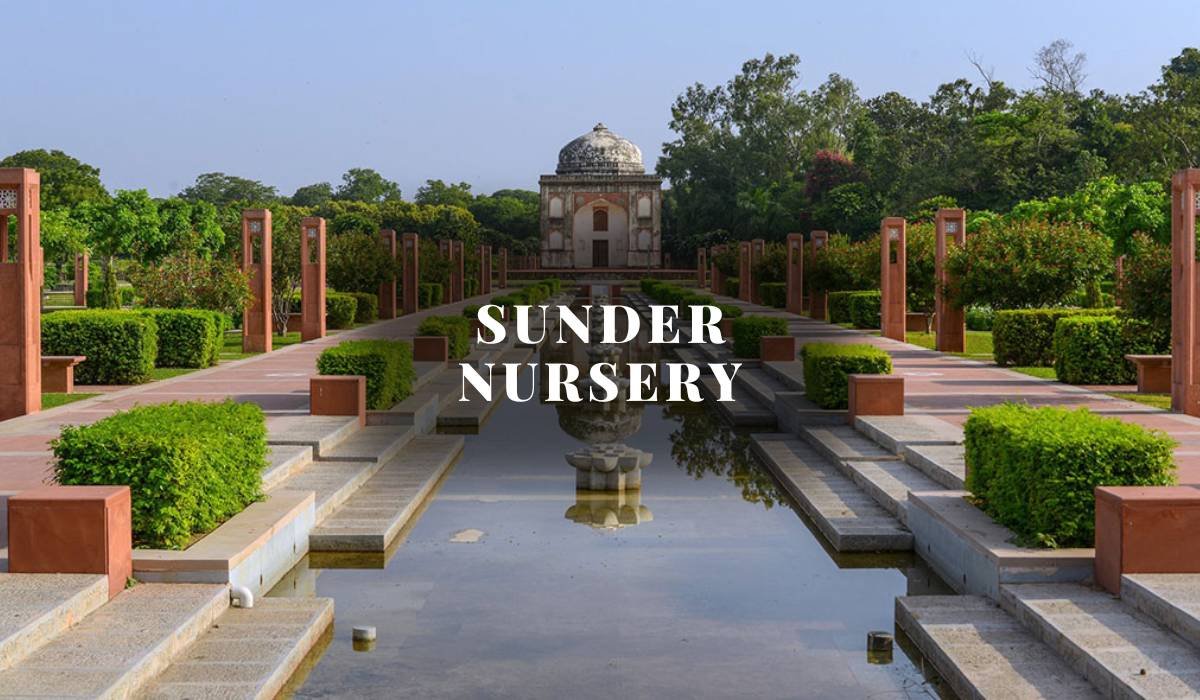About Sunder Nursery:
Sunder Nursery, once known as Azim Bagh in Mughal times, is a lovely garden in the heart of Delhi. It’s close to famous places like Humayun’s Tomb and Hazrat Nizamuddin Auliya’s dargah. This green paradise was created back in the 20th century to grow plants for New Delhi.
At first, it was all about raising plants and trees for the new capital city. Tests were also done on plants from all over India and other places. What kinds of plants can survive Delhi’s tough weather?
Sunder Nursery’s Highlights
- World Heritage Site: The beautiful World Heritage Site of Humayun’s Tomb is right next to this green oasis, which adds to its historical charm.
- Birds: A lot of different kinds of birds love the grounds, which makes them a perfect place for people who love birds and nature.
- Trees of Sunder Nursery: Explore the huge variety of trees that grow in this lovely garden. They provide shade and natural beauty.
- Water Gardens: Enjoy the peace of water parks, where the sound of running water creates a calm atmosphere.
- Butterflies: The bright butterflies that live in Sunder Nursery will charm you.
- Flowers of Sunder Nursery: There are many beautiful flowers in the yard right now, making it a visual treat.
- Biodiversity Zone: The beautiful nursery is a great place to learn about plants and the environment. Because it works to protect the natural species of Delhi and encourage diversity.
About 90 acres of land make up Sunder Nursery. It was surprising that only a small part of it was being used as a nursery when they started to fix it up. They thought of a good way to improve things in 2008 and put it into action. To make a great place for everyone to enjoy, they mixed the history of the nursery with nature and beautiful views.
Sunder Nursery’s Transformative Landscape Master Plan:
Sunder Nursery, known as Azim Bagh, has a long history dating back to the early 1900s. It was very important to grow trees and plants for the new British city and to try types from all over India and other places. With the help of the Nizamuddin Urban Renewal Initiative, old cities will look better and be more alive again. To do this, we created a landscape master plan with the help of CPWD. As soon as ASI, MCD, DUAC, and CPWD approved it in January 2009, civil work could start.
The master plan has three main components:
- Enhancing and improving the nurseries.
- Creating formal and sensitive settings around places from the Mughal time of the 1600s. The area is now part of Humayun’s Tomb World Heritage Site.
- Settling on biodiversity zones, which include bird and butterfly habitats and local plant species from the Delhi area.
This master plan is based on the traditional Indian idea of uniting wildlife, gardening, and usefulness. It also focuses on protecting the environment. Its goal is to turn Sunder Nursery into a big urban green place that adds to the area’s beauty and historical value.
The Historic Significance of Sunder Nursery’s Location
Sunder Nursery is located in the middle of Delhi, south of Lutyens’ New Delhi. Next to the famous Humayun’s Tomb World Heritage Site, it’s on an area of 25.66 ha. A short walk to the east will bring you to the dargah of Hazrat Nizamuddin Aulia, a famous Sufi saint who lived in the 1300s. Spread out over 90 acres, Sunder Nursery is right in the middle of Delhi. It is home to 20 historic buildings, six of which are UNESCO World Heritage Sites. Some of these interesting historical sites are close to the well-known Humayun’s Tomb. Like Humayun’s tomb, each of them has undergone meticulous restoration by the Aga Khan Trust for Culture.
The Purana Quila Road and the Firoz Shah Kotla Road go north to the Red Fort. The lovely Lodhi Path goes to the Safdarjung Tomb in the west, which is a park from the late Mughal era. When it comes to Delhi’s past, Sunder Nursery is right in the middle of all the important spots.
The whole point of the repair job is to keep the old ways of living. A team of skilled builders, architects, and engineers uses old tools, methods, and materials to bring back the magic of the past. They have fixed up houses and found detailed clay designs, among other amazing things. In 2010, they found another Mughal-era water tank from the 1600s. You can find this lovely lotus pond close to Sundarwala Palace. The park has restored its past beauty, adding a touch of history.
Sunder Nursery: Development, Ecology, Heritage, and Sustainability
Nursery Development
- Size and History: Less than 10% of the 90-acre Sunder Nursery that was once used as a nursery was used to start the change. Finding ways to use its past, beauty, and natural resources to make it a cultural hub. CPWD helped make a master plan for this in 2008.
- Largest Nursery: Sunder Nursery uses twenty acres to grow and showcase plants. This makes it the biggest nursery in Central Delhi.
Biodiversity and Ecology
- Green Belt: Along Mathura Road, Sunder Nursery, Humayun’s Tomb, Batashewala Complex, Delhi Zoo, and Purana Qila make up a natural belt. It’s a haven for diverse bird species and an opportunity to conserve Delhi’s biodiversity.
- Microhabitats: Since 2009, some of the land that used to hold construction trash. They have been turned into small homes for animals. The project’s goals are to make Delhi’s natural beauty better and make students and visitors more aware of environmental issues.
Heritage Conservation
- Historic Monuments: At Sunder Nursery, you can see many old buildings, including the Lakkar Wala Burj, Sundar Burj, Sunderwala Mahal, Mughal Garden Pavilion, Arched Platform, Lotus Pond, and more. These are being carefully fixed up because they are part of a World Heritage Site.
- Landscaping: The surroundings of these monuments are thoughtfully landscaped to enhance their historic character and provide a dignified setting.
Post-Project Sustainability
- Revenue Generation: To ensure the park’s self-sufficiency, the planners have included revenue-generating elements such as an auditorium, restaurants, and meeting rooms.
- Trust for Sustainability: Some people have advised that the project go on with the help of a trust plan and the Secretary of MoUD in charge. It should also have people from AKF, AKTC, ASI, CPWD, and SDMC. This plan doesn’t involve giving up land and makes sure that the spot is always maintained.
Restoring the Beauty of Sunder Nursery A Glimpse into Conservation
There is something wonderful going on at Sunder Nursery. Historic sites, such as old wells and buildings from long ago, are being brought back to life. Let’s look at the hard work that is being done to protect this lovely spot.
Desilting Historic Wells:
There are some very old wells in Sunder Nursery. People haven’t used these wells for water in thirty to forty years. They cleaned them up now, though! People dug out the dirt and trash from the wells with ropes and buckets. They worked hard, but they did it.
The Mughalera Lotus Pond:
They also found an old lotus pond that was almost falling apart. But they didn’t let it crumble. They carefully fixed it, and now lotus flowers bloom there again. This pond is a special place for art and cultural events, and it’s the first thing you see when you visit the park.
Sundarwala Mahal:
One of the important old buildings here is the Sunderwala Mahal. It’s a bit like a time machine from the 16th century. They fixed the walls, decorated them, and made them strong again. It’s like bringing history back to life.
Mughal Garden Pavilion:
There was a beautiful gazebo tucked away in the trees. But it almost got lost. They worked very hard to save it. They got rid of all the plants that had taken over, fixed the cracks, and even put the pretty patterns back on. It looks beautiful now.
Arched Platform:
This special place is a bridge between the park and the wild area. It was almost forgotten, but they brought it back to life. They fixed it and made the surroundings look nice. It’s a perfect spot for picnics and fun events for kids.
Lakkarwala Burj Garden:
Here, there’s a building that’s almost 500 years old. It’s on a high platform and looks very pretty. They repaired it, brought back the decorations, and made it strong again. It’s like giving a beautiful old thing a fresh start.
Sunder Burj Gardens:
It’s like a secret gem here. There are a few other old garden tombs like this one. They made it even more beautiful by working together and getting help from other people. It is now a World Heritage Site, which means it is part of something very important.
There is more to Sunder Nursery than just parks. It is a place where history comes to life. Many people worked hard to keep these old gems safe so that future generations can enjoy them. You can email info@sundernursery.org to find out more.
Sunder Nursery Heritage Park Photos / Images
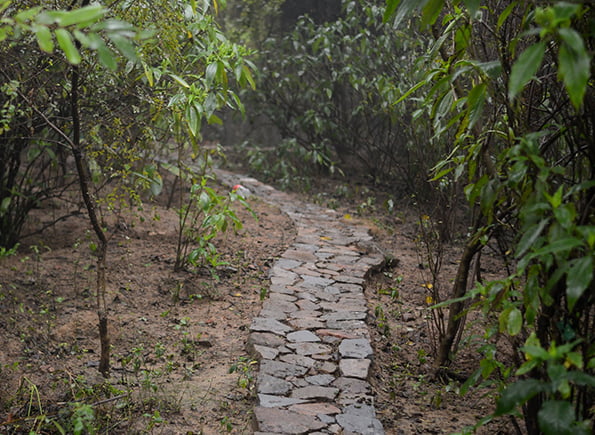
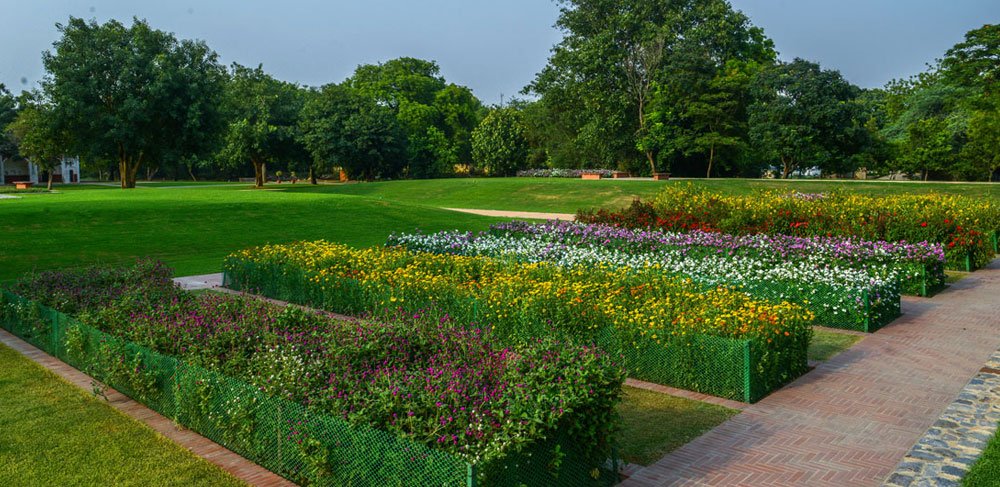

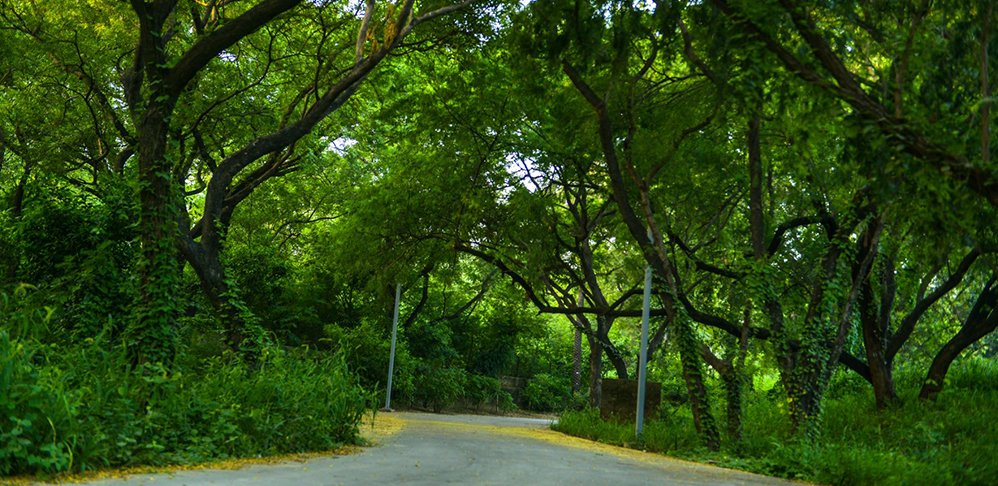

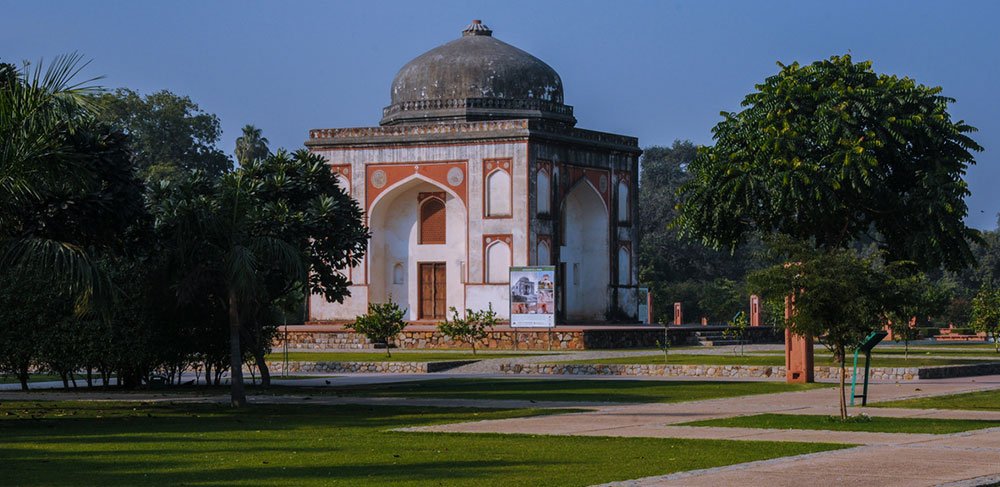
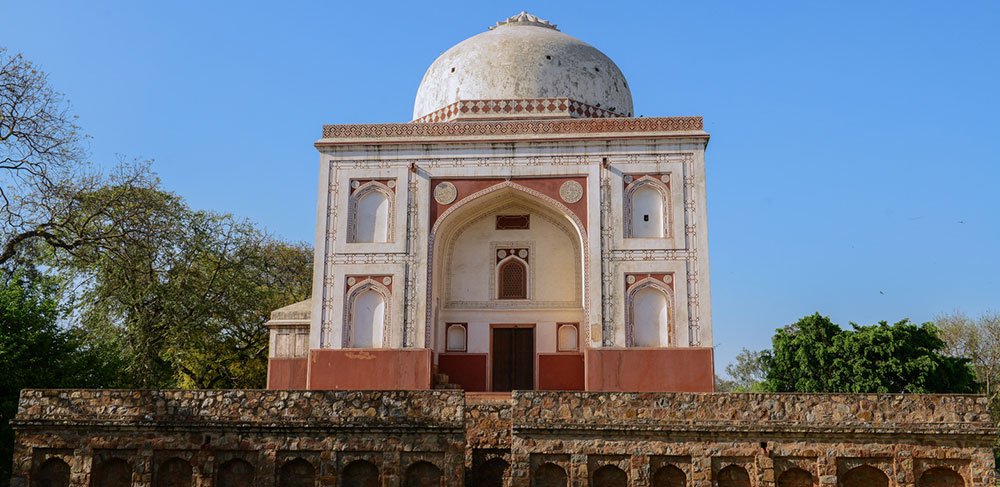
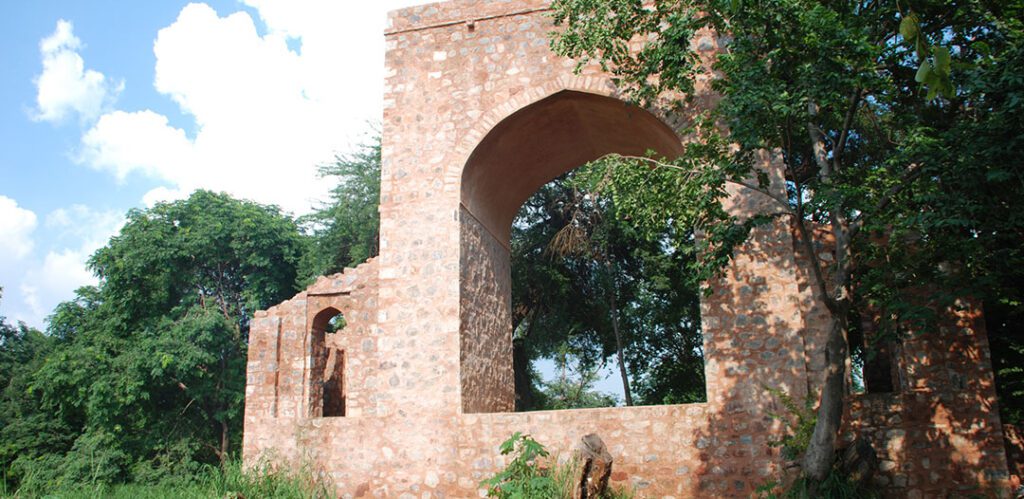
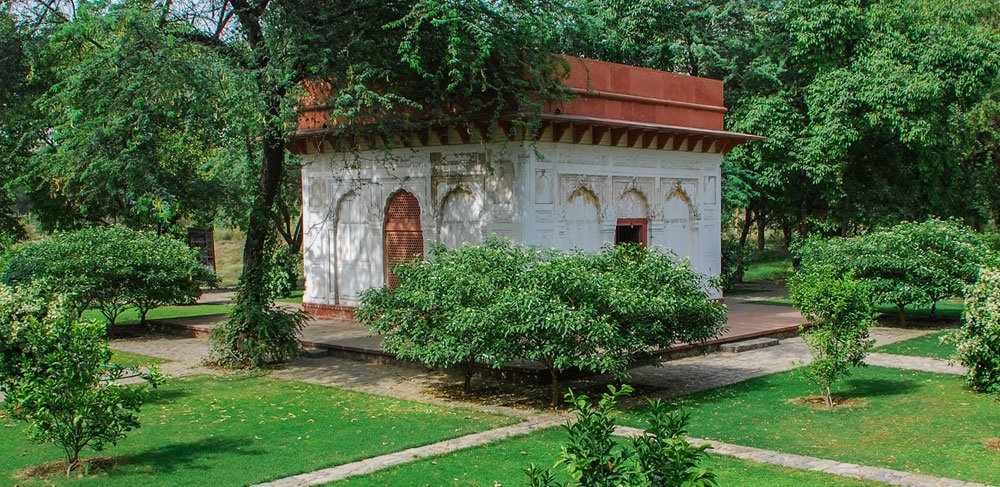
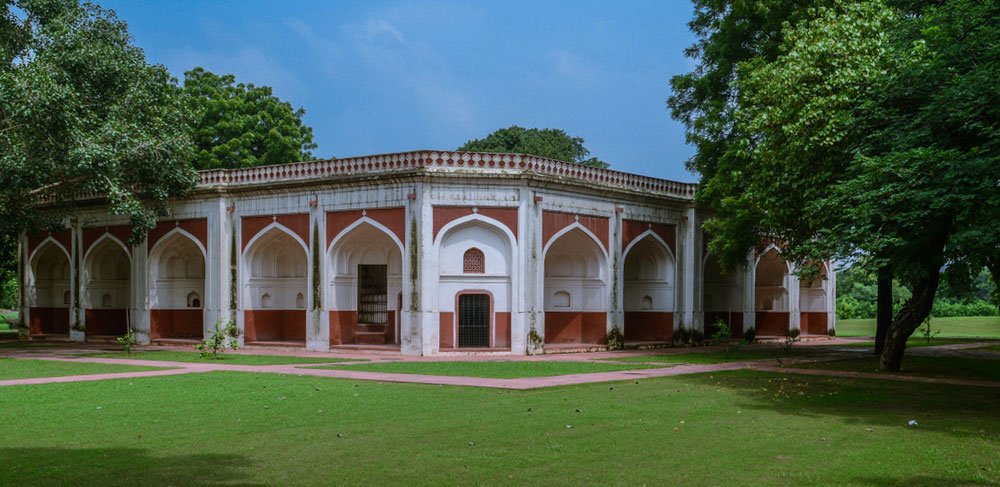
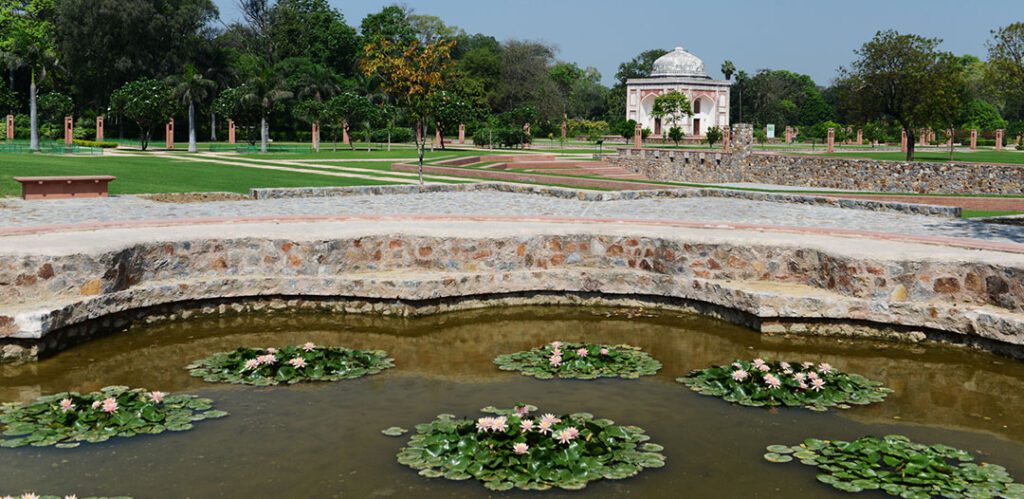
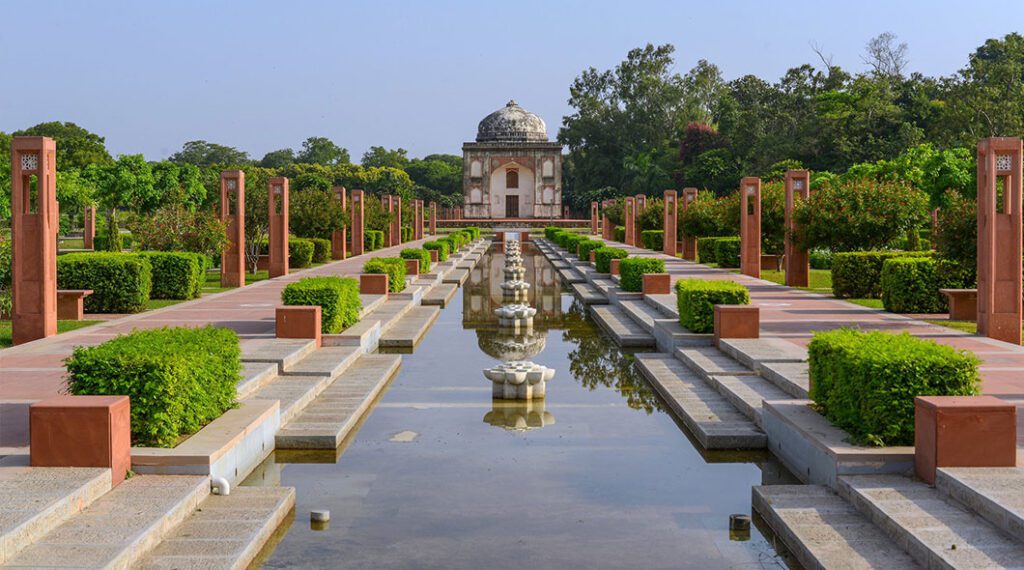
Sunder Nursery’s Natural Wonders A Haven for Wildlife and Biodiversity
Sunder Nursery is not just about history and old structures; it’s also a nature sanctuary. Let’s take a stroll through this green paradise and discover its amazing ecology.
The Wilderness Zone:
This part of the nursery is like a magical forest. It’s home to almost 300 different kinds of trees. Birds love it here, especially the peacocks who come to nest on the ground. Thanks to some hard work, they removed lots of rubble and planted 20,000 baby trees. Now, the place is alive with over 80 types of birds and 60 kinds of butterflies.
MicroHabitat Zone for Education:
An extra 20-acre space is set aside to help the 500,000 school kids who visit Humayun’s Tomb every year learn about nature. From hills to rivers to lakes, Delhi used to have a lot of different kinds of plants.
Delhi’s Original Ecosystems:
In another 30-acre area, they created different zones that show what Delhi’s nature used to be like. It’s like stepping back in time to see how the land once was. They even planted more than 100 types of trees that belong to this area.
Educational Facilities:
They didn’t forget about teaching people. They added places where you can learn about plants and nature. It’s a fun way for kids and everyone to understand how important it is to take care of our environment.
Trees of Sunder Nursery:
The garden has a lot of great trees. Some are very old—nearly 100 years old—and some are so rare that you won’t find them anywhere else in the city. So much so that they made a map that shows you where all the trees are.
Nature and History Combined:
Things from the past and the present come together at Sunder Nursery. They made sure that the old trees and landmarks were safe and that nature and the new trees did well. It’s more than just a park; it’s a lesson about the Earth and a trip through time.
Creating Delhi’s Bird Habitat:
Birds love Sunder Nursery. They come here to live and play. You can see all kinds of birds, like peacocks, ducks, and storks. It’s a paradise for them, and it’s right here in Delhi.
Sunder Nursery is like a hidden gem in the city. It’s a place where you can explore the past and connect with nature. It’s a gift to Delhi and to all of us who love history and the great outdoors. Come and visit, and this natural wonderland will amaze you with its beauty.
Sunder Nursery’s EcoWonderland A Haven for Bees and Nature Lovers
In Sunder Nursery, there is more than just a park. There is also a nature center where animals like bees can grow. Let’s take a better look at how Sunder Nursery is bringing these important animals to people’s attention and making them full of life.
Bee Conservation & Awareness:
In the wild, bees are like gods because they spread pollen, which helps plants grow. The fact that these beautiful animals are in danger because of drugs and ruined homes breaks my heart. We want to keep them safe here at Sunder Nursery. We gave different kinds of bees safe places to live and taught our staff how to take care of them.
Mapping Bee Hotspots:
Imagine making a map of where bees love to hang out. That’s what we did at Sunder Nursery. We marked all the spots where honeybees love to visit during the flowering months. We even found special bees like Apis Cerana, Apis dorsata, and Apis Florea, and we’re taking care of them.
Educational Workshops:
We want everyone to know how cool bees are. So, we host workshops where visitors, especially kids, can learn about bees. We talk about their life, how they make honey, and even how to use beeswax to make heel care cream. Plus, we give out free samples of natural honey!
Working with Experts:
We teamed up with the Golden Hive Foundation, and they teach our team how to look after bee boxes. These boxes are like little bee homes. We even have special bee boxes with stingless bees and Apis Mellifera bees for visitors to see.
Columbia University Collaboration:
We believe that bees are super important for our world. So, we joined hands with Columbia University Global Centre to spread the word. We launched the Don’t Be Afraid campaign to tell everyone about bees and why we should save them.
Sunder Nursery Lake:
Did you know that every drop of rainwater in Sunder Nursery is precious? It goes to our lakes and underground tanks, and it even recharges ancient wells. We made sure these wells were clean and deep again. Our lakes are home to many water-loving plants, and they store lots of water for the park.
Garden House:
If you like being outside, the Garden House at Sunder Nursery is like a school. This is proof of how beautiful and varied our world is. We made a microhabitat zone with hills, riverine, alluvial, and swampy places to bring back Delhi’s wildlife, which is going away. It looks like a small forest in the city.
Sunder Nursery is a place where history and nature go hand in hand. It’s a home for bees, birds, and countless plants. It’s a school for anyone who wants to learn about the wonders of our planet. So, come visit us and be part of the mission to save our bees and our environment.
Sunder Nursery All Attraction:
That’s not all that Sunder Nursery has to offer. It’s also a place for living naturally and healthily. We can’t wait to tell you all about the Farmers Market and the other fun things you can do at Sunder Nursery Heritage Park.
Farmers Market: Embrace Organic Living
A Farmers Market by Earth Collectives is held at Sunder Nursery. It’s a celebration of natural, organic, and environmentally friendly life. Look at a variety of goods that have been carefully chosen to help you and the world. This market is great for people who care about their health because it has fresh farm goods, handmade goods, and a lot more.
Attractions A to Z: A Journey of Discovery
Look around Sunder Nursery and see all its interesting features, such as the peaceful arboretum and the stunning rose garden. You can read about the different things you can do under each section. Now let’s talk more about the great things you can do at Sunder Nursery:
- Arboretum: Discover a vast collection of over 300 tree species.
- Arc of Discovery: Uncover the wonders of nature.
- Butterflies: Bees, and Birds: Witness these amazing creatures in their natural habitat.
- Children’s Garden: A special place for the little ones.
- Canna Gardens: A burst of colorful blooms.
- Dragonflies and Damsel Flies: Marvel at these graceful insects.
- Cultural Heritage: Explore the rich history and culture.
- Flower Valley: A paradise of beautiful blooms.
- Fig Trees: Discover unique and ancient trees.
- Garden Amphitheater: Where nature meets entertainment.
- Grass Gardens: Relax in the serene greenery.
- Herb Garden: A fragrant oasis of herbs.
- Insect Hotel: A charming dwelling for tiny creatures.
- Jhoolas: Swing and enjoy the outdoors.
- Kingfishers: Spot these majestic birds.
- Lotus Pond: Be captivated by the beauty of lotus flowers.
- Lake: A serene water feature for relaxation.
- Mughal World Heritage Sites: Explore our historical treasures.
- Microhabitats: Discover Delhi’s diverse ecosystems.
- Nursery: Where it all began.
- Orioles and Owls: Observe these fascinating birds.
- Paradise Garden: A true slice of heaven.
- Peacock Habitat: Home to our national bird.
- Heritage Walk: Join a guided tour.
- Rivulets: Flowing streams of beauty.
- Rose Garden: A fragrant and colorful delight.
- Satin Leaf Tree: Unique and enchanting trees.
- Serenity Amphitheatre: Find peace and tranquility.
- Urban Oasis: Escape the city hustle.
- Vermicomposting: Learn about eco-friendly practices.
- Wilderness: Get lost in nature’s embrace.
- Memory of a Loved One: Reflect and remember.
- Yellow Flowers: Bright and cheerful blossoms.
- Zaika Picnic: Enjoy a delightful picnic.
You can get in touch with nature, learn about history, and live a healthy life at Sunder Nursery. There’s something here for everyone, whether you want to shop at the Farmers Market or just look around our cool sites. So, come to Sunder Nursery and enjoy the natural beauty.
Rules for Dog Owners
If you plan to visit the park with your dog, please follow these guidelines:
- Leash Your Dog: Always keep your dog on a leash while in the park. If we see your pet without a leash, we may restrict your entry.
- Stay Away from Water Bodies and the Wilderness Zone: For the sake of the earth, keep your dog away from bodies of water and the forest area.
- Carry Cleanup Equipment: Be responsible and carry equipment or a bag to pick up after your dog. Keep the park clean.
- Do Not Feed Stray Dogs: Avoid feeding wild dogs because it’s important to keep the park clean and healthy.
Remember that it’s all of our duty to keep the park and its grounds clean so that everyone can enjoy them.
School Visits at Sunder Nursery Heritage Park:
All kinds of training groups are welcome at Sunder Nursery, from those with kids from birth to college students who are going on their own. When you visit a school, these things will likely happen:
What to Expect:
- We welcome educational organizations from early years to university excursions.
- Enjoy the outdoor classroom setting at Sunder Nursery.
- Choose between self-led visits and education sessions.
- During education classes, our experts lead hands-on arts and crafts and environmental activities.
Booking Information:
- We recommend at least two hours for your visit, starting at 7 a.m.
- Check our opening hours and planned closures before visiting.
- Education sessions run from 10:30 a.m. to 4:00 p.m.
- Booking is essential, whether for self-led visits or education sessions.
- Booked sessions include a tailored itinerary for your pupils’ participation.
If your school wants to learn more while enjoying the outdoors, plan a field trip to Sunder Nursery.
Venue Descriptions at Sunder Nursery Heritage Park
Garden Amphitheatre
A spot nestles between two historic sites and neighbors a Mughal Lotus Pond from the 17th century. You can get to the Garden Amphitheater through pretty flower beds and well-kept fields. It’s a piece of Delhi’s past and a peaceful green space. On top of that, it has green rooms connected for your comfort.
Exhibition Area
The Sunderwala Mahal is a World Heritage Site, and this grass is right next to it in its Hasht-Bihisht Park. Tall trees that are over a hundred years old make a great setting for casual events. When the sun goes down, the memorial lights up beautifully from the outside, making a beautiful background. It is handy that it is easy to get to by car and park.
Picnic Park Zone
There is plenty of room for big groups to get together in the Picnic Park Zone. Whether it’s a neighborhood fair, a lively concert, or an art show, it’s a blank slate for your event’s ideas. It’s easy for guests to come and go because it’s connected to park paths and close to the road around the outside.
Lawn North of Amphitheatre
This rich green field is great for both big and small groups. It is located between the Sunder Burj and the Sunderwala Mahal, both of which are World Heritage Sites. It’s close to the Garden Amphitheater and has lights made of monolithic rock that add to the atmosphere.
Market Plaza
The Market Plaza is a large, flat area that works well for events with lots of units or stands. You can see a beautiful garden on one side and the garden tomb of Mirza Muzaffar Hussain from the 1600s on the other. It’s easy to get to from the road, and there are two parking spots.
| Venue | Area | Price (Rs + GST) |
|---|---|---|
| Garden Amphitheatre | 1455 sqm | 50,000 |
| Picnic Park Zone | 5000 sqm | 3,50,000 |
| Exhibition Area | 3415 sqm | 2,00,000 |
| Lawn North of Amphitheatre | 3300 sqm | 5,00,000 |
| Market Plaza | 2800 sqm | 2,50,000 |
| Lawn West of Playhouse Area | 2000 sqm | 1,50,000 |
| Lake-side Lawn | 1335 sqm | 5,00,000 |
| Mughal Pavilion Garden | 1125 sqm | 1,00,000 |
| Sunken Gardens | 550 sqm | 75,000 |
| Birthday Party Lawn | 1200 sqm | 15,000 |
Sunder Nursery Park Timings:
| Park Timings | Details |
|---|---|
| Days of the Week | Seven days a week |
| Opening Hours | 7:00 am to 10:00 pm |
| Last Entry | 9:30 pm |
| Year-Round Access | The park is open every day of the year. Special circumstances are communicated through social media channels and notice boards. |
| Ticketed Events | During ticketed events, access to the park is limited to non-ticketed areas only. |
| Under Construction | Areas under construction, such as the Garden House, Museum, and Restaurant blocks, are not accessible to the public. |
Sunder Nursery Heritage Park Ticket Price:
| Category | Price (in INR) |
|---|---|
| Adults | Rs. 50 |
| SAARC Citizens | Rs. 50 |
| Children (5-12 years) | Rs. 25 |
| Children under 5 | Free |
| Older Citizens (Indian) | Rs. 25 |
| Older Citizens (Non-Indian) | Not Applicable |
| Foreign Tourists | Rs. 200 |
| Disabled Person | Free |
Parking Fees (Inside Sunder Nursery Park):
| Vehicle Type | Price (in INR) |
|---|---|
| Car Parking (4 hours on weekdays) | Rs. 100 |
| Car Parking (4 hours on Sundays and Gazetted holidays) | Rs. 200 |
| Two-Wheeler (4 hours) | Rs. 35 |
Parking Inside Sunder Nursery
| Parking Type | Capacity | Charges (For up to 4 Hours) |
|---|---|---|
| Two-wheelers | – | Rs. 35 |
| Cars (Weekdays) | 320 Cars | Rs. 100 |
| Cars (Sunday & Gazetted holidays) | 320 Cars | Rs. 200 |
Western Parking (Near Subz Burj Circle)
| Parking Type | Capacity | Charges (For up to 4 Hours) |
|---|---|---|
| Two-wheelers | – | Rs. 25 |
| Cars | 110 Cars | Rs. 50 |
Eastern Parking (Near Gurudwara Damdama Sahib)
| Parking Type | Capacity | Charges (For up to 4 Hours) |
|---|---|---|
| Two-wheelers | – | Rs. 25 |
| Cars | 100 Cars | Rs. 50 |
| Mini-Buses | – | Rs. 75 |
| Buses | 42 Buses | Rs. 100 |
Please note that these parking details are subject to change, so it’s advisable to verify the current rates and availability before your visit. Enjoy your time at Sunder Nursery!
Sunder Nursery Heritage Park Annual Membership Pass Price:
| Membership Category | Price per Year | Details |
|---|---|---|
| Individual | Rs 3,000/- | Unlimited access for an individual guest for a year. |
| Family Pass | Rs 7,500/- | For a family of two adults and two children (both below 15 years). |
| Special Pass | Rs 2,000/- | For older citizens and children between 5 and 12 years. |
| Quarterly Pass | Rs 1,000/- for adults, Rs 750/- for Older Citizens | Valid for 3 months. |
Please note that annual passes are typically received within 10 working days, and they are valid for 12 months from the date of issue. The pass is non-transferable and can only be used by the authorized holder. Residents of Hazrat Nizamuddin Basti may receive a 50% subsidy on their Annual Passes from the Aga Khan Foundation (AKF).
nearby attraction of Sunder Nursery
- Humayun’s Tomb: Historical marvel and architectural brilliance.
- India Gate: Symbol of pride, perfect for a stroll.
- Purana Quila, Delhi: Ancient history within majestic walls.
- Lodhi Garden: Serene oasis with historical tombs.
- Akshardham: Spiritual retreat with stunning architecture.
- National Zoological Park, Delhi: A wild retreat for nature lovers.
- National Museum, New Delhi: Dive into India’s cultural heritage.
- Lotus Temple: Tranquil haven with lotus-inspired architecture.
- National Gallery of Modern Art: Explore contemporary art.
- Khan Market: Shop, dine, and soak in urban vibes.
- Ugrasen Ki Baoli: Ancient Stepwell’s architectural depth.
- Jama Masjid: Majestic mosque, Mughal grandeur.
- Red Fort: Iconic fortress resonating with history.
- Jantar Mantar: UNESCO-listed site for astronomical wonders.
Sunder Nursery Park Delhi Video
Conclusion
In conclusion, Sunder Nursery, formerly known as Azim Bagh. There is a 90-acre paradise in the heart of Delhi that is a seamless blend of history, nature, and sustainability. Its transformative landscape master plan has revitalized the site. Due to this, it has become a center of wildlife, biodiversity, and cultural enrichment. This hidden gem offers a unique experience. Which connects visitors to history, nature, and a vibrant educational and cultural center. Come to immerse yourself in the beauty and purpose of a beautiful nursery.
FAQs
Sunder Nursery is Delhi’s first arboretum, home to rare trees like the Pink Cedar, Chukka, and Carrotwood, found nowhere else in Delhi.
Absolutely! It’s well-maintained, a UNESCO site, and a delightful place with peacocks, birds, bees, butterflies, flowers, lemon trees, and restored monuments. The entry fee is just Rs. 35 per adult.
There’s no restaurant, but picnics are allowed. It’s open 7 days a week.
No, for the health and enjoyment of all, alcohol and smoking are not allowed.
Yes, there are two toilet blocks in the park, conveniently located near the main attractions and lawns.
Sunder Nursery, formerly known as Azim Bagh or Bagh-e-Azeem, is a 16th-century heritage park complex next to Humayun’s Tomb, a UNESCO World Heritage Site in Delhi.
The nearest metro station is JLN Stadium Metro Station on the Violet Line, just 1.5 km away from the park.
Sunder Nursery, established in 1913 by the British, is situated on the historic 16th-century Grand Trunk Road.
Time magazine recognized Sunder Nursery as a must-visit place, and it has seen over two lakh visitors since opening to the public in February.

